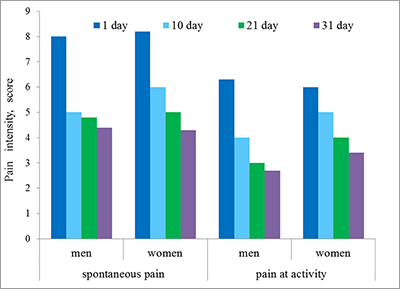The 40th Anniversary of the Institute of Physiologically Active Compounds of the Russian Academy of Sciences
Analysis of Immunochemical Parameters in Vertebrogenic Pain Syndrome
Institute of Physiologically Active Compounds of the Russian Academy of Sciences, 1 Severny proezd, Moscow region, Chernogolovka, 142432 Russia,*e-mail: annalevashova3@gmail.com
Key words: vertebrogenic pain syndrome; natural antibodies; β-endorphin; orphanin FQ; serotonin; dopamine
DOI: 10.18097/BMCRM00039
The immune system can react to pain by synthesis of the natural antibodies to pain-regulating mediators which affect the nervous system. In this study, the analysis of content antibodies to opioid peptides (β-endorphin and orphanin FQ) and biogenic amines (serotonin and dopamine) in vertebrogenic pain syndrome (PS) was carries out in serum of PS patients. It has been found that this PS is accompanied by an increase in the production of antibodies to the neurotransmitters studied, and the immune response to opioid peptides is more profound than to biogenic amines. The antibodies levels were higher in female patients than in males (especially for orphanin FQ). These data indirectly correlate with the PS intensity and the dynamics of its regression, evaluated using a visual analogue scale (VAS). Thus, the pain intensity measured by VAS in women was higher, in compare with men and the dynamics of decrease was lower. In addition, it was found that during the significant decrease of the pain intensity, there was no significant decrease in antibody levels to antinociceptive mediators. Apparently, this observation indicates the antibodies to antinociceptive mediators can effect the mechanisms of transition from acute to chronic pain and in maintenance of chronic pain.


|
Figure 1.
The dynamics of pain decrease in different functional stages (spontaneous pain and pain at activity) in the male and female groups.
|


|
Figure 2.
The dynamics of pain decrease in different functional stages (night pain and pain at rest) in the male and female groups.
|
|
CLOSE

|
Table 1.
Parameters of the levels of studied natural antibodies (OD450 in ELISA (М±SD)) in serum blood samples of examined individuals (patients and control) in the male and female groups
|
|
CLOSE

|
Table 2.
The distribution of patients in the male and female groups depending on the levels of n-Abs under studied by groups: lowered, elevated and high level (%)
|
ACKNOWLEDGEMENTS
The work was carried out within the framework of the Program of Fundamental Scientific Research of the State Academies of Sciences for 2013-2020 (State Registration No. 01200952666). The authors thanks the doctor of the Department of Neurology of RMAPE Moseikin Ilya Aleksandrovich for collecting and providing the clinical and biological material of the patients being examined.
REFERENCES
- Pavlenko, S.S. (2007) Boli v nizhnej chasti spiny (ehpidemiologiya, kliniko-diagnosticheskaya klassifikaciya, sovremennye napravleniya v diagnostike, lechenii I standartizacii medicinskoj pomoshchi): rukovodstvo. Novosibirsk: Sibmedizdat, NGMU, 172 p.
- Reshetniak, V.K., Kukushkin, M.L. (2015) Modern understanding of the physiological and pathological pain. Clinical Pathophysiology, 1, 1-17.
- Jensen, I.B., Bodin, L., Ljungqvist, T., Gunnar Bergstrom, K., Nygren, A. (2000) Assessing the needs of patients in pain: a matter of opinion? Spine, 25 (21), 2816–2823.
- Golubev, V.L, Vein, A.M., Danilov, A.B. (2005) Gender and pain. Zh Nevrol Psikhiatr Im S.S. Korsakova, 10, 72–74.
- Kravchenko, L.M. (2011) Gender variations in German-speaking patients’ Description of pain. Vestn. Volgogr. State Univers. Ser. 2, Linguistic, 2 (14), 91-95.
- Williamson, A., Hoggart, B. (2005) Pain: a review of three commonly used pain rating scales. J. Clin. Nurs, 14 (7), 798–804. DOI
- Ovsyannikov, V.G., Boychenko, A.E., Alekseev, V.V., Kapliev, A.V., Alekseeva, N.S., Kotieva, I.M., Shumarin, A.E. (2014) Antinociceptive system. Medical Herald of the South of Russia, 3. 46-54. (In Russ.). DOI
- Pan, H.L., Wu, Z.Z., Zhou, H.Y., Chen, S.R., Zhang, H.M., Li, D.P. (2008) Modulation of pain transmission by G-protein-coupled receptors. Pharmacol Ther, 117(1), 141-161. DOI
- Degenhardt, B.F., Darmani, N.A., Johnson, J.C., Towns L.C., Rhodes, D.C.J., Trinh, C., McClanahan, B., DiMarzo, V. (2007) Role of osteopathic manipulative treatment in altering pain biomarkers: a pilot study. J Am Osteopath Assoc, 107, 387-400.
- Barnes, T.A., Lambert, D.G. (2004) Editorial III: Nociceptin/orphanin FQ peptide-receptor system: are we any nearer the clinic? Br. J. Anaesth., 93, 626–628. DOI
- Chiou, L.C., Liao, Y.Y., Fan, P.C., Kuo, P.H., Wang, C.H., Riemer C., Prinssen, E.P. (2007) Nociceptin/orphanin FQ peptide receptors: pharmacology and clinical implications. Current drug targets, 8(1), 117-135. DOI
- Voznesenskaya, Т.G. (2008) Chronic pain and depression. Pharmateka, 6, 10-15.
- Hernandez-Reif, M., Field, T, Krasnegor, J, Theakston, H. (2001) Lower back pain is reduced and range of motion increased after massage therapy. Int. J. Neurosci., 106(3-4), 131-145. DOI
- Poletaev, А.B. (2010) Physiological Immunology: Natural Autoantibodies and Nanomedicine Problems. Publisher. Miklosh, Moscow, 218 p.
- Polyvyanaya, O.Y., Levashova, A.I., Morozova, V.S., Petrochenko, S.N., Myagkova, M.A., Moseikin, I.A. (2015) Dynamics of pain tolerance thresholds and humoral immunity factors at dorsalgy. Vestnik Rossiiskoi akademii meditsinskikh nauk. 70(1), 118-124 (In Russ.). DOI
- Igonkina, S.I., Vetrile, L.A., Zaharova, I.A., Kukushkin, M.L. (2015) Antibodies to neuromediators at neuropathic pain. Neuroimmunologia. 12(1-2), 45-46.
- Myagkova, M.A., Lushnikova М.V., Polevaya, О.Yu. (1992) Immunoglobulins binding biogenic amines in patients with drug dependence. Immunology. 3, 45-47.

